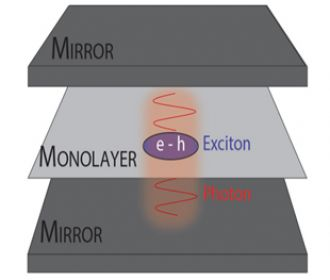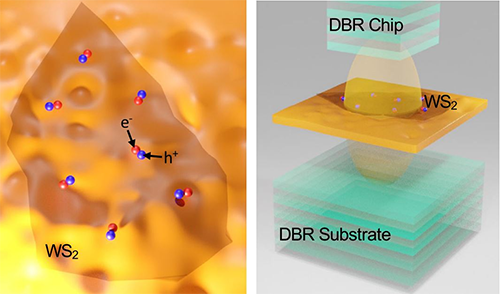| Oct 04, 2021 |
Sandwich-style construction: towards ultra-low-energy exciton electronics
(Nanowerk News) A new ‘sandwich-style’ fabrication process placing a semiconductor only one atom thin between two mirrors has allowed Australian researchers to make a significant step towards ultra-low energy electronics based on the light-matter hybrid particles exciton-polaritons.
|
|
The breakthrough (Nature Communications, "Motional narrowing, ballistic transport, and trapping of room-temperature exciton polaritons in an atomically-thin semiconductor"), led by the Australian National University, demonstrated robust, dissipationless propagation of an exciton mixed with light bouncing between the high-quality mirrors.
|
|
Conventional electronics relies on flowing electrons, or ‘holes’ (a hole is the absence of an electron, ie a positively-charged quasiparticle).
|
|
However, a major field of future electronics focusses instead on use of excitons (an electron bound to a hole) because, in principle, they could flow in a semiconductor without losing energy by forming a collective superfluid state. And excitons in novel, actively studied atomically-thin semiconductors are stable at room temperature.
|
|
Atomically-thin semiconductors are thus a promising class of materials for low-energy applications such as novel transistors and sensors. However, precisely because they are so thin, their properties, including the flow of excitons, are strongly affected by disorder or imperfections, which can be introduced during fabrication.
|
 |
| Microcavities are micrometre-scale structures with an optical medium sandwiched between ultra-reflective mirrors, used to confine light such that it forms exciton-polaritons.
|
|
The ANU-led FLEET team—with colleagues at Swinburne University and FLEET Partner institution Wroclaw University—has coupled the excitons in an atomically-thin material to light to demonstrate for the first time their long-range propagation without any dissipation of energy, at room temperature.
|
|
When an exciton (matter) binds with a photon (light), it forms a new hybrid particle – an exciton-polariton. Trapping light between two parallel high-quality mirrors in an optical microcavity allows this to happen.
|
|
In the new study, a new ‘sandwich-style’ fabrication process for the optical microcavity allowed the researchers to minimise damage to the atomically-thin semiconductor and to maximise the interaction between the excitons and the photons. The exciton-polaritons formed in this structure were able to propagate without energy dissipation across tens of micrometres, the typical scale of an electronic microchip.
|
MICROCAVITY CONSTRUCTION IS THE KEY
|
|
A high-quality optical microcavity that ensures the longevity of light (photonic) component of exciton-polaritons is the key to these observations.
|
|
The study found that exciton-polaritons can be made remarkably stable if the microcavity is constructed in a particular way, avoiding damage of the fragile semiconductor sandwiched between the mirrors during fabrication.
|
|
“The choice of the atomically-thin material in which the excitons travel is far less important,” says lead and corresponding author Matthias Wurdack.
|
|
“We found that construction of that microcavity was the key,” says Matthias, “And while we used tungsten sulfide (WS2) in this particular experiment, we believe any other atomically-thin TMDC material would also work.”
|
|
(Transition metal dichalcogenides are excellent hosts for excitons, hosting excitons that are stable at room temperature and interact strongly with light).
|
 |
| Left: Electron-hole pairs in atomically-thin WS2 on a substrate where dielectric disorder is similar size to excitons. Right: Hybridisation of excitons and photons leads to formation of polaritons in an all-dielectric high-Q optical microcavity, reducing effect of dielectric disorder.
|
|
The team built the microcavity by stacking all its components one by one. First, a bottom mirror of the microcavity is fabricated, then a semiconductor layer is placed onto it, and then the microcavity is completed by placing another mirror on top. Critically, the team did not deposit the upper mirror structure directly onto the notoriously fragile atomically-thin semiconductor, which is easily damaged during any material deposition process.
|
|
“Instead, we fabricate the entire top structure separately, and then place it on top of the semiconductor mechanically, like making a sandwich,” says Matthias.
|
|
“Thus we avoid any damage to the atomically-thin semiconductor, and preserve the properties of its excitons.”
|
|
Importantly, the researchers optimised this sandwiching method to make the cavity very short, which maximized the exciton-photon interaction.
|
|
“We also benefitted from a bit of serendipity,” say Matthias. “An accident of fabrication that ended up being key to our success!”
|
|
The serendipitous ‘accident’ came in the form of an air gap between the two mirrors, making them not strictly parallel.
|
|
This wedge in the microcavity creates a voltage/potential ‘slope’ for the exciton-polaritons, with the particles moving either up or down the incline.
|
|
The researchers discovered that a proportion of exciton-polaritons travel with conservation of total (potential and kinetic) energy, both up and down the incline. Travelling down the slope, they convert their potential energy into equal amount of kinetic energy, and vice versa.
|
|
That perfect conservation of total energy means no energy is being lost in heat (due to friction), which signals ‘ballistic’ or dissipationless transport for polaritons. Even though the polaritons in this study do not form a superfluid, the absence of dissipation is achieved because all scattering processes that lead to energy loss are suppressed.
|
|
“This demonstration, for the first time, of ballistic transport of room-temperature polaritons in atomically-thin TMDCs is a significant step towards future, ultra-low energy exciton-based electronics,” says group leader Prof Elena Ostrovskaya (ANU).
|
|
Apart from creating the potential “slope”, that same fabrication accident created a potential well for exciton-polaritons. This enabled the researchers to catch and accumulate the travelling exciton-polaritons in the well – an essential first step for trapping and guiding them on a microchip.”
|
LONG-RANGE, ROOM-TEMPERATURE FLOW OF EXCITON-POLARITONS
|
|
Furthermore, the researchers confirmed that exciton-polaritons can propagate in the atomically-thin semiconductor for tens of micrometres (easily far enough for functional electronics), without scattering on material defects. This is in contrast to excitons in these materials, the travel length of which is dramatically reduced by these defects.
|
|
Moreover, the exciton-polaritons were able to preserve their intrinsic coherence (correlation between signal at different points in space and time), which bodes well for their potential as information carriers.
|
|
“This long-range, coherent transport was achieved at room temperature, which is important for development of practical applications of atomically-thin semiconductors” said Matthias Wurdack.
|
|
If future excitonic devices are to be a viable, low-energy alternative to conventional electronic devices, they must be able to operate at room temperature, without the need for energy-intensive cooling.
|
|
“In fact, counterintuitively, our calculations show that the propagation length is getting longer at higher temperatures, which is important for technological applications,” said Matthias.
|


